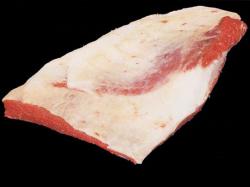Top Of The Food Chain: Brisket
May 28, 2010 | 2 min to read

Brisket can conjure the smell of a billowing smoker, the warmth of friends and family at Passover, or a disappointing cut of tough, blackened meat. It holds a firm place in varied traditions, largely because it is a large and economical cut. While often a fickle piece of meat to cook, with enough patience and a solid technique you can produce a voluminous amount of tender meat on the cheap.
Brisket
Brisket, which is cut from the shoulder of the cow, must be cooked low and slow for best results. The cut is usually cheap, around $2.00 or less a pound. If you go to buy brisket at the supermarket, you’ll usually find two different cuts: Packer, which has all of the fat cap, and Trimmed (sometimes Super Trimmed). The supermarket I go to usually has a few of both, but generally has more of the Packer cut.
In Texas, brisket is a barbecue staple. A Texas-style brisket is smoked for hours and served on white bread with pickles, onions, cheddar cheese, and barbecue sauce, with sides of baked beans and potato salad or coleslaw. Brisket is also commonly served at Jewish Passover celebrations. The meat braises for hours in a pot with onions, carrots, and garlic. Traditional sides for the brisket are haroset (a fruit and nut spread), matzo ball soup, and an unleavened cake.
Variations
Both the Packer and the Trimmed variation feature two “sections” to the meat, called the flat and the point. The point is the knobby looking part of the brisket at one end, and rests on top of the flat, which makes up the bulk of the cut of meat.
To read the rest of this story please go to: Eat Me Daily Blog
